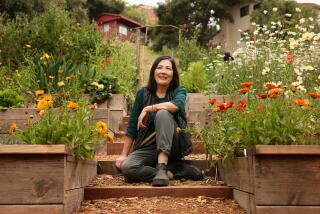Pamela Ingram; Ran Topanga Nursery
- Share via
Very little ever stumped Pamela Ingram.
She could tell you how to cultivate clematis, where to get David Austin roses and how to exorcise aphids.
She knew a great deal about honeybees, silver poodles and Siamese cats.
But she conceded that she was a little nonplused when a 6-year-old boy once asked: “Does it hurt the lettuce to eat it?”
Ingram said hesitantly, “Well . . . no,” thought a bit and then explained: “The lettuce wants to be a part of everything--of the whole world. When we eat the lettuce, it gets its wish.”
Ingram, who owned Sassafras Nursery in Topanga Canyon for nearly 20 years, died Saturday in her Topanga home of a heart attack at the age of 81, said her friend and former employee Ronnie Corbett.
The English-born Ingram, who founded the nursery in 1979 and operated it until its closure two years ago, became known for her advice and supplies for planting English-style gardens with a profusion of perennial plants and flowers. She had no problem getting plants better adapted to the wet and gloom of England to flourish in sunny, near-desert Southern California, and she assured customers they wouldn’t either.
“It’s just not true that clematis won’t grow here,” she told The Times in 1990, describing a flowering vine she had liked in Britain and successfully nurtured in Topanga Canyon to the height of a three-story building.
“Each year we sell 300 to 400 clematis vines,” she said, “and thousands of our customers are growing them, mainly due to our influence and education. Clematis can be grown successfully by novice and experienced gardeners alike.”
The vines “like their feet in the shade and their heads in the sun. They need good, fast-draining soil since they don’t like to stand in soggy soil. Since the roots are tender, they do well with a good covering of mulch. But the vines require some sun for flowering.
“It’s also a matter of common sense. If the garden is in a hotter environment, the vine will need more shade. And the vine needs more sun if the garden is heavily shaded.”
The point-by-point advice, with her folksy references to plants as if they were human beings, was typical of Ingram, who thoroughly enjoyed her pioneer efforts in the rustic canyon.
She advised customers to try new plants and always to teach their children how to plant, grow and enjoy what they reaped, whether it was flowers or something edible.
“It’s a natural thing to do,” she told The Times in 1993, advocating family gardening. “On a fine spring morning, you want to go out. It’s a question of nurturing.”
For parents who had no idea how their children would react, she assured them that youngsters loved planting seeds and watching for something to sprout.
Hardy, fast-growing plants like sunflowers or peas were best, she always said, because “it’s hard for children to wait.”
Ingram immigrated first to Chicago and then came to Los Angeles in the 1950s with her husband, whom she later divorced, and their two children. She was appalled, she told The Times in 1995, by “these cement sidewalks and hills with palm trees and . . . the whole awful mess.”
So the family drove out to Topanga Canyon, which half a century ago had only a handful of residents, and soon settled there. Initially, Ingram bred and sold silver poodles and Siamese cats. Later she became a beekeeper, and in 1979 her lifetime of growing things culminated in the founding of the nursery.
Over the decades, Ingram endured Topanga’s legendary fires, floods, mudslides and high winds. Once she had to fight a trespassing charge when surveyors determined that much of the nursery was located in the publicly owned Topanga State Park.
“I no longer care about possessions because I have lost so many of them,” she said in 1995.
But she also never considered moving or relocating her business.
“You buy a piece of property and you don’t know what is going to happen,” she said. “It is like with a child. They fall down and hurt themselves and you fix it. You don’t give the child up. And once you’ve been somewhere so long, you become a part of it. I can’t imagine living anywhere else.”
Ingram is survived by her son, David Alley, and daughter, Deborah Harper.






